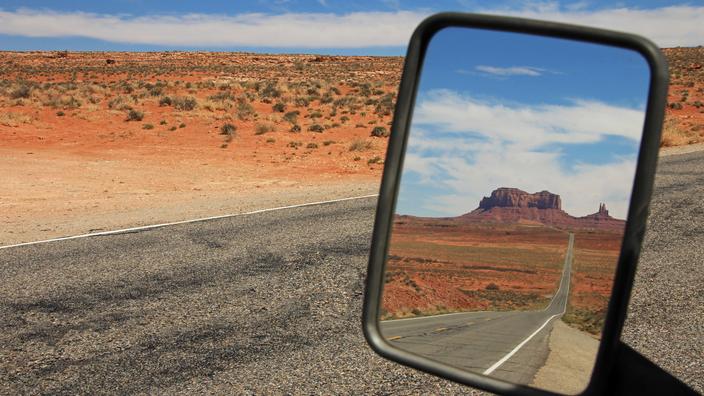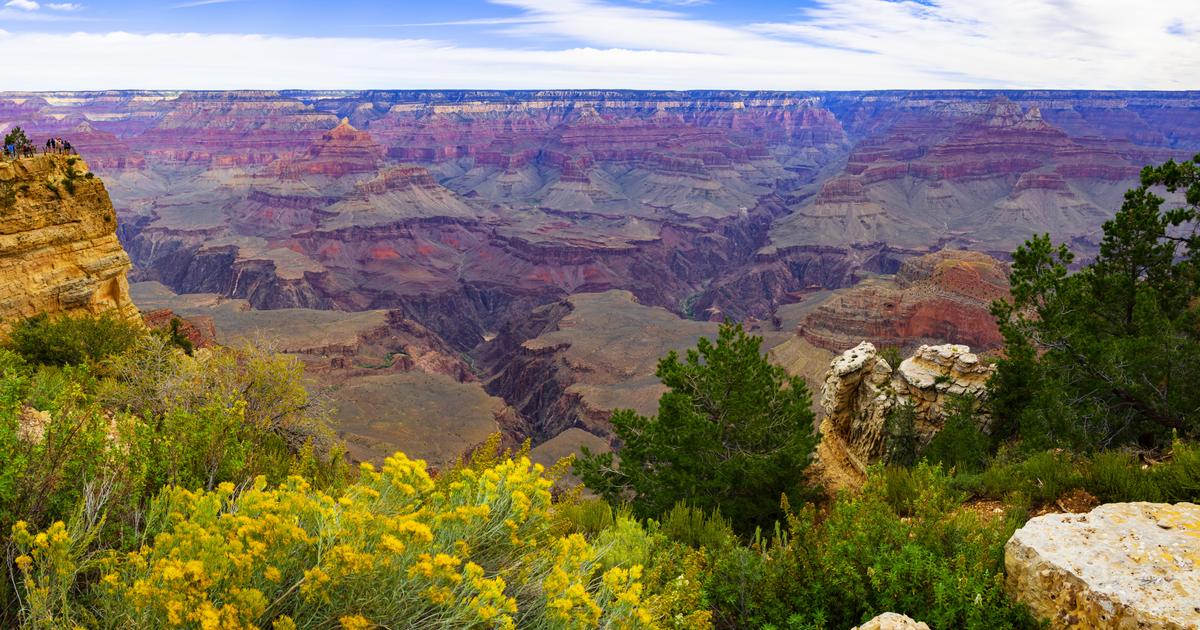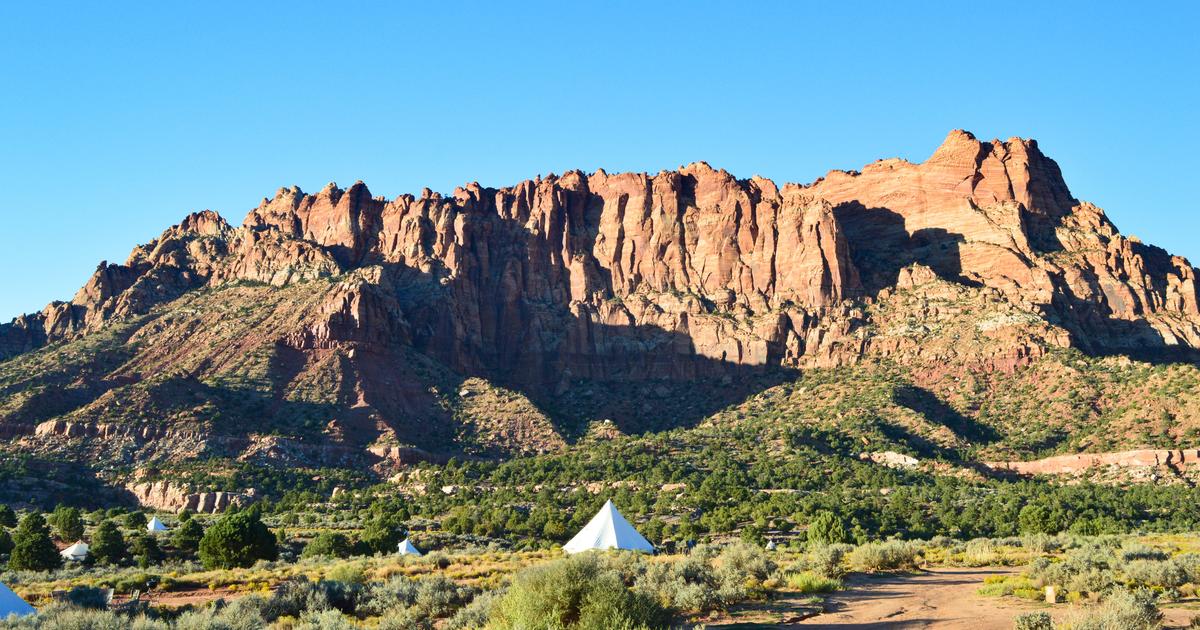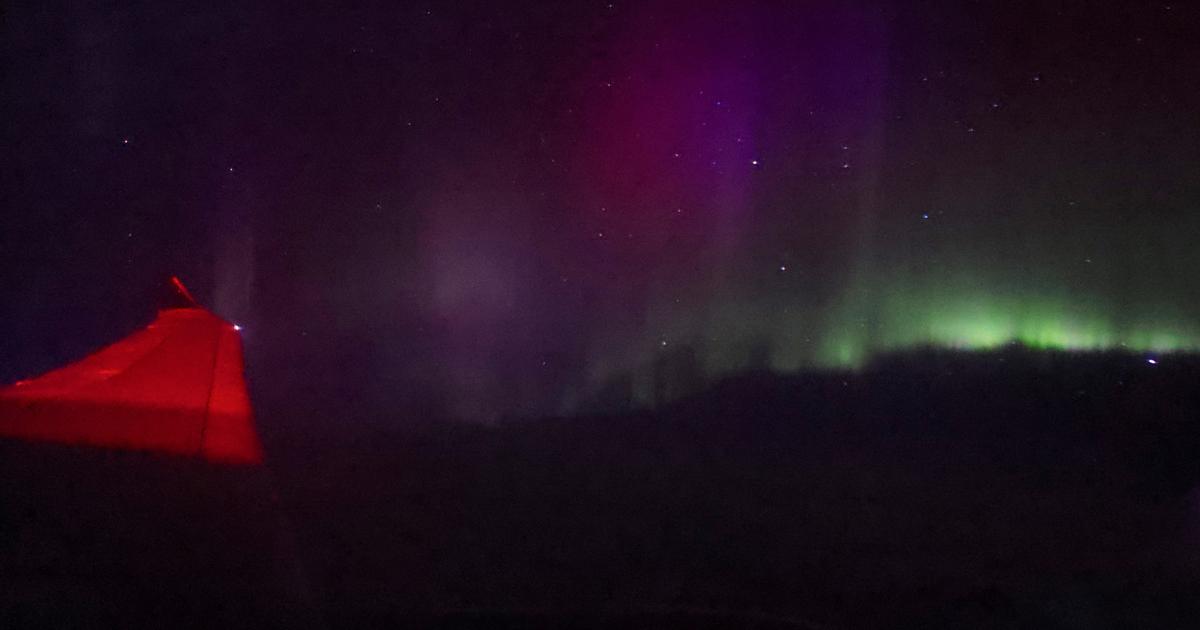Created by millennia of climatic and geological forces, the wilderness of the National Parks of the American West is among the most spectacular destinations in the United States.
While the country has about sixty national parks, created by decision of Congress, those from California to Colorado, via Nevada, Utah and Arizona, are certainly legendary.
They concentrate eternal images of America: road trip on Route 66, western scenery, immensities as far as the eye can see.
Here, time has stood still and Man seems to have no hold.
Here is a selection of 10 national parks, chosen for their majesty and diversity, presented for a loop tour from Los Angeles.
On the way to a life-size show!
Read also: Pastry road trip in Los Angeles with François Perret
Joshua Tree National Park, for Joshua trees
Joshua Trees in Joshua Tree National Park.
Adobe Stock
About fifty kilometers east of Palm Springs, in southern California, the wind turbines are reminiscent of
Rain Man's
convertible
rides
.
We enter the Mojave Desert, bristling with Joshua trees.
Belonging to the yucca family (and not that of the cacti), they were named in the 19th century by the Mormon pioneers, the first community to have set foot in this desert.
The shape of the trees in fact reminded them of Joshua indicating the Promised Land.
These arid expanses are populated by coyotes and pumas.
The 1.6 km
Hidden Valley
Loop Trail
weaves
its way through boulders of granite set on the sandy ground, dotted with scattered bushes that add a touch of greenery.
These granite blocks are also a playground for climbing enthusiasts.
Our advice
Cut the road between the fields of wind turbines planted in the middle of the desert while listening to the soundtrack of the film
Rain Man
.
Bewitching!
Practical information
Entrance fee: $ 30 per vehicle.
More info on the National Parks Service website
Grand Canyon National Park, for the vertigo of grandeur
Spectacular: the view of both sides of the Grand Canyon from a helicopter.
Adobe Stock
We are now in Arizona, in southeastern California.
The Grand Canyon of Colorado, a gigantic plateau cut into canyons, is one of the most impressive geological phenomena in the world.
At the bottom of the canyon, the Colorado River meanders through the rock.
The depth of the canyon can reach up to 1,829 m, for a width of nearly 29 km.
On the north shore, along the
Hermits Rest Route
, a free shuttle serves promontories and cliffside terraces.
The sometimes shaded path that runs along the canyon offers dizzying viewpoints, to be found among the pines and junipers.
From
Grandview Point
,
Lipan Point
and
Moran Point
, the spectacle is unforgettable.
Over 2 billion years of geological history stretch as far as the eye can see.
Vertigo of greatness guaranteed!
Our advice
While the south shore is more frequented, the north side is more intimate.
Watch the sunrise or sunset, to admire the play of light and shade on the foothills of the canyon.
At dusk, the cliffs seem to set ablaze, and each passing minute seems to reinvent the landscape by adorning it with new colors.
Practical information
Entrance fee: $ 35 per vehicle.
Free shuttles run to promontories.
More info on the National Parks Service website
Read also: Route 66, journey on one of America's most powerful myths
Monument Valley, for its western decor
Monument Valley, one of the most photogenic stages of the road trip.
Adobe Stock
En route to the far north of Arizona, to the border with Utah.
On the horizon of the road, the silhouettes of red sandstone peaks emerge in a straight line.
Here is Monument Valley, one of the most photogenic stages of the road trip.
They stand on the red and powdery sand of sacred Navajo territory, in shades of red and ocher: a legendary landscape.
The geomorphological formations with steep slopes give the park all its singularity.
There are two types.
A
mesa
is a rock formation wider than it is high, topped by a plateau.
When they are taller than they are wide, rock formations are called
butt
.
The site served as the backdrop for many legendary westerns, including
The Fantastic Ride
,
Rio Grande
and
The Massacre of Fort Apache
.
John Ford's westerns, in particular, made the valley a must-see in the history of the western and the seventh art, thanks in particular to the rides of John Wayne.
Our advice
Valley Drive
forms a 27 km loop in the heart of the most beautiful rock formations.
At dusk, the peaks radiate glowing colors and lengthen their shadows on the sand.
Photographing yourself in the immensity of
John
Ford Point
, immortalized in the Western
Prisoner of the Desert
.
Practical information
Since the valley is located in Navajo lands, Monument Valley is not a
strito sensu
national park
.
Entrance fee: $ 20 per vehicle.
More info on the Navajo National Parks website
Mesa Verde National Park, for its Indian troglodyte villages
The
kivas
of Long House Cliff Dwelling in the Mesa Verde National Park.
Adobe Stock
We continue the road east, inland, towards Colorado, near the meeting point of Utah, Arizona, New Mexico and Colorado.
Mesa Verde
, "green plateau", was named by the Spaniards in the 17th century.
The park owes its fame to the cave dwellings on the cliff side, once inhabited by the Anasazi Amerindians.
This sedentary nomadic people experienced its golden age between the 12th and 14th centuries.
The upper plateau was used for agriculture, while they had set up their houses in natural alcoves on the cliff.
Religious ceremonies were celebrated in the
kivas
, semi-underground circular spaces.
Mesa Verde thus unfolds a lesson in archeology
in situ
, discovering a civilization that has not yet revealed all its secrets.
Our advice
While some rooms in
Balcony House
can be accessed by ladders and tunnels,
Cliff Palace
is more accessible, and just as representative.
It is also the largest troglodyte complex in North America, to be favored in the grazing light of the evening.
Practical information
Entrance fee: $ 30 per vehicle from early May to late October, $ 20 the rest of the year.
More info on the National Parks Service website
Arches National Park, for its natural rock arches
The natural red sandstone arches of Arches National Park at the blazing hour of sunset.
Adobe Stock
Head west and back to Utah.
Arches National Park's natural red sandstone arches are the result of extreme temperatures and slow erosion.
There are nearly two thousand of them throughout the park, of various shapes, sometimes massive, sometimes delicate, sometimes double or triple.
If they are the celebrity of the park, the arches are next to other rock constructions: cairns, pinnacles, fairy chimneys, cliffs and other buttes with improbable shapes.
Today, it is rainwater that erodes the rock and carries sediment to the Colorado River.
In winter, snow accumulates in the cavities, giving the decor surprising white notes.
Our advice
Explore the park on foot, on discovery trails planned for varying durations, from 15 minutes to 5 or 6 hours.
Double Arch
and
Windows Section
, multiple contiguous arches, are easily accessible after short walks.
At the end of the day, walk to
Delicate Arch
, balanced on the edge of the precipice.
The
Devil's Garden
path
also features particularly photogenic arches.
Practical information
Entrance fee: $ 30 per vehicle.
More info on the National Parks Service website
Bryce Canyon National Park, for its
hoodoos
and fairy chimneys
View of Bryce Canyon.
In this gigantic limestone plateau, erosion has carved out a canyon.
Adobe Stock
Bryce Canyon is also located in Utah, further south.
Like the Grand Canyon, Bryce Canyon is approached from the heights of the plateau.
The visit opens with a bird's eye view of the amphitheater below.
The discovery continues down the trails to the bottom of the canyon.
In this gigantic limestone plateau, erosion has carved out a canyon.
He dotted himself with a forest of fairy chimneys called
hoodos
, with a thousand shades of ocher and red, consequences of the oxidation of minerals.
Pines, firs and spruces sit side by side with pitons in a chromatic alliance between mineral and vegetal.
On the wildlife side, the park is teeming with chipmunks, these small rodents gathering with striped squirrels.
Our advice
The best viewpoints are Bryce Point, Inspiration Point, Sunset Point and Sunrise Point.
From the viewpoints on the plateau, the most beautiful lights are captured in the morning.
Plunging to the bottom of the canyon, the
Queens Garden Trail
crisscrosses it along a sandy path, winding between pinnacles and conifers.
A delicious looping wandering in the heart of an almost dreamlike mineral universe.
Practical information
Entrance fee: $ 35 per vehicle.
More info on the National Parks Service website
Zion National Park, for a vision of paradise on earth
Zion is first discovered at the foot of the colossal cliffs.
The Virgin River has carved its bed between the mountains, giving this Garden of Eden the air of the land of giants.
Adobe Stock
Still in southern Utah, Zion is a paradise of water, vegetation and rock.
Here we are in the footsteps of Mormon pioneers, whose epic remains one of the greatest migrations in American history.
They are the ones who discovered the valley, and baptized it in reference to the biblical Zion, this kingdom of God which they dreamed of restoring.
Long before them, Indians worshiped the site.
Unlike the Grand Canyon and Bryce Canyon, which we start by gazing at from the heights of the plateaus, Zion is first discovered at the foot of colossal cliffs.
The Virgin River has carved its bed between the mountains, giving this Garden of Eden the air of the land of giants.
The
Esmerald Pools Trail
leads to natural
pools
in steps.
The Narrows
hike
owes its name to its circuit in the canyon bed.
The hiker is led to set foot in the regenerating freshness of the Virgin River, whose sacredness recognized by elders, Indians and Mormons.
Our advice
Treat yourself to a night in one of the wooden cabins at
Zion Lodge
(count US $ 220 for a "
western cabin
").
At dusk, when the walkers desert the valley, silence and nature take back all their rights.
In the early morning, the deer come to graze the meadows at the doors of the huts.
An enchanting experience!
Practical information
Entrance fee: $ 35 per vehicle.
More info on the National Parks Service website
Yellowstone National Park, for its colors and its geysers
In Yellowstone, fumaroles, hot springs and geysers compete for the spotlight.
Adobe Stock
Head north, towards Wyoming, on the borders of Idaho and Montana.
Established in 1872, Yellowstone was the world's first national park.
On a mountainous plateau in the Rockies, this kingdom of fire and ice sits on one of the largest calderas in the world.
This ruggedly beautiful landscape was shaped by geothermal forces that continue to exert themselves with panache.
Yellowstone owes its name to the homonymous river, a tributary of the Missouri, which flows between yellow sandstone cliffs.
At the foot of the mountains, in the valleys, on the edge of pine forests and at the foot of snow-capped peaks, mud pools, fumaroles, hot springs and geysers compete for the spotlight.
The natural pools offer an explosion of colors, from turquoise to orange.
This ecosystem is a paradise for bison, bears and wolves.
Our advice
Follow the trails of the Lamar Valley and the sides of the Grand Canyon of Yellowstone.
The
Old Faithful
Geyser
is one of the most famous.
Its eruptions are announced at the
Visitor Center
.
Practical information
Entrance fee: $ 35 per vehicle.
More info on the National Parks Service website
Yosemite National Park, for its giant sequoias
At the foot of the mountains grow forests of pines and giant sequoias.
Adobe Stock
Return south and to California, in the San Francisco hinterland.
In the heart of the Sierra Nevada, here is one of the most beautiful glacial valleys in the world, where the Merced river flows, a remnant of the glacier.
At the foot of the mountains grow forests of pines and giant sequoias.
All in verticality, they rival in size with the monolithic granite cliffs, here called
domes
.
Climbing to the
Lembert Dome
promises a view of the subalpine valley of Tuolumne Meadows.
In the distance loom the mountains of the Sierra Nevada.
Olmsted Point
offers one of the most beautiful panoramas in Yosemite.
In the distance,
El Capitán
and
Half Dome
, the two largest monolithic cliffs in Yosemite, draw the skyline.
To go in search of specimens of giant sequoias, you have to go deep into Tuolumne Grove.
A path winds at the foot of the conifers.
Finally, do not miss the Wawona tree-tunnel, more than 2,000 years old.
As for wildlife, bears, wolves, pumas and deer frolic in the shade of the conifers.
Our advice
Bears abound in the park.
To avoid attracting them, food must be kept in a metal box (
bear box
).
Practical information
Entrance fee: $ 35 per vehicle.
More info on the National Parks Service website
Death Valley National Park, for its polychrome geological formations
Almost lunar volcanic rock hills, Sahara-like sand dunes.
This is the Valley of Death.
Adobe Stock
Let's stay in the Californian interior.
Like Zion, Death Valley owes its name to Mormons grateful for not having perished in these hostile lands.
Later, the fates of other less fortunate travelers - pioneers and gold diggers - recalled the threat of the name.
The winds and erosion have left expanses of desolation: hills of almost lunar volcanic rock, sand dunes resembling the Sahara.
On
Artist's Drive
, the palette of mineral pigments (mica, manganese, etc.) brought out astonishing colors: ocher and brown tones, pink tones and hints of green.
This valley is located in one of the hottest and lowest spots in the United States.
Badwater Basin
, a desert made from the crystallized ash of a salt lake, is the hottest and driest point in the country, but also the lowest in North America (86 m below sea level).
If some have met a disastrous fate, others have exploited minerals in the valley (borax, copper, silver, gold and lead).
Be careful, the oases of Furnace Creek and Stovepipe Wells are the only drop-off points in the valley.
Our advice
Tread the lunar expanses of
Zabriskie Point
when the light softens on the draped folds of the rock.
Be careful, summer temperatures are extreme, it is best to visit the park from October to April.
Practical information
Entrance fee: $ 30 per vehicle.
More info on the National Parks Service website
Practical notebook
When to
go to the national parks of the American West?
It is extremely hot in summer, which is also the busiest season.
In Death Valley, it's even the furnace.
For milder temperatures and less crowds, prefer spring or fall.
In the Rockies and northern parks like Yellowstone, the harsh winter can extend until June.
How long to leave?
While 2 weeks is a minimum for a comprehensive overview, 3 weeks is more comfortable.
We generally opt for a loop tour, departing from Los Angeles, or San Francisco.
How to get around the parks?
The United States being the kingdom of the road-trip, the ideal is to cross the parks by car or camper van (
RV
or
motor home
).
In some parks, free shuttles have been put into service in order to preserve the environment, in order to limit the number of vehicles in circulation.
Shuttles (
shuttle buses
) are sometimes optional, like in Bryce Canyon, sometimes mandatory in certain sectors, like at the Grand Canyon.
What budget for visiting the national parks of the American West?
Entrance fees vary significantly from park to park, from nothing to $ 35.
This package is valid for one vehicle, regardless of the number of passengers and for 7 consecutive days.
The American the Beautiful Annual Pass gives access to all national parks as well as national monuments.
It covers its holder and 3 other adult passengers (free for children under 16).
Priced at $ 80, it pays for itself from the 3rd park.
Note: this pass does not give access to Monument Valley, which is not a national park but a “tribal park”.
Do I have to reserve?
Yes !
For summer in particular, booking accommodation at the start of the year is strongly recommended.
Various tips
Do not underestimate the dangers associated with the extreme heat of summer.
Make sure you have water and enough gasoline, as petrol stations are scarce in remote areas.







/cloudfront-eu-central-1.images.arcpublishing.com/prisa/2H3Z3GJU7NB4PBWQNG6QANTFQY.jpg)

